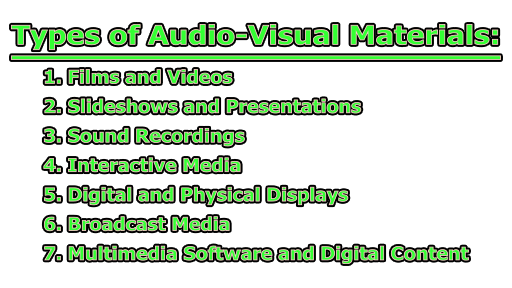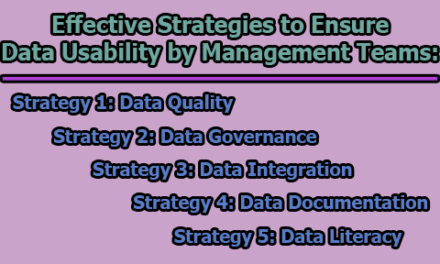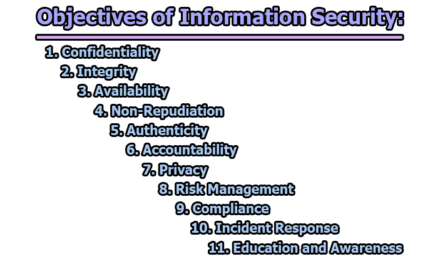Audio-Visual Materials:
Audio-Visual materials are an engaging way to communicate, mixing sound and visuals to inform, entertain, and educate. These resources can take many forms, including videos, films, presentations, animations, audio recordings, and interactive content. By combining sound, images, and sometimes text, they create a rich and immersive experience for the audience. This makes them incredibly valuable for a variety of uses, such as improving learning experiences, simplifying complex ideas, and connecting with viewers on an emotional level. Whether they’re used in classrooms, the entertainment industry, corporate settings, or artistic projects, audiovisual materials are essential to modern communication and continue to evolve alongside technology and the needs of the audience. In the rest of this article, we will explore the Audio-Visual Materials: Types, Applications, Benefits, Features, Needs, and Enhance the Learning Experience in Educational Settings.
What is Audio-Visual Material?
Audio-Visual (AV) Material is all about coming together sound and visuals to create a captivating way to share ideas and information. Unlike regular text that just uses words, AV materials incorporate images, videos, sounds, and often some interactive elements too. This mix not only makes things more engaging but also helps the audience grasp complex or abstract ideas more easily. For example, when students watch educational videos, they can better visualize scientific concepts. In the business world, presentations that combine visual slides and audio explanations can effectively communicate strategies or data in a memorable way.
The significance of AV materials has really exploded with the rise of technology, especially in education, business, and entertainment. In schools, AV content caters to different learning styles, making it easier for both visual and auditory learners to thrive. In the corporate sphere, tools like webinars, video conferences, and engaging presentations have become vital for training and working together from different locations. Entertainment has also evolved with AV materials; think about how streaming services, films, and virtual reality bring stories to life in vivid detail. Whether for teaching, informing, or entertaining, AV materials provide a flexible and impactful way to communicate, improving accessibility, engagement, and understanding in ways that traditional methods simply can’t match.
Types of Audio-Visual Materials:
Let’s explore the different types of AV materials and their applications in our daily lives.
1. Films and Videos: Probably the most familiar type of AV material, films and videos include everything from movies and documentaries to instructional videos and recorded lectures. They present information using a mix of visuals, sound, and often text, making them fantastic tools for storytelling and education. Whether it’s a documentary about ecosystems or a training video for a new job, films and videos excel at grabbing attention and breaking down complex ideas.
Where You’ll Find Them: You’ll see these everywhere—in classrooms, online courses, corporate training sessions, marketing campaigns, and of course, in entertainment. Thanks to platforms like YouTube and Netflix, accessing films and videos has never been easier.
2. Slideshows and Presentations: These tools cleverly combine images, text, and sometimes audio to present information in a tidy format. Programs like PowerPoint and Google Slides enable users to create visually striking presentations that mix text with charts, images, and even videos. This format is particularly handy for digesting topics in manageable sections, making them easy to follow and understand.
Common Uses: You’ll find slideshows in business meetings, classrooms, and conferences, where they’re used to communicate strategies, data, or key messages effectively.
3. Sound Recordings: This category includes audiobooks, podcasts, music, and recorded lectures, offering a purely auditory experience that resonates particularly well with auditory learners. Sound recordings can often accompany other AV materials for a well-rounded learning experience. For instance, a recorded lecture might pair well with a visual slideshow.
Where They Shine: These recordings are fantastic for language learning, storytelling, sharing information, and supporting online learning platforms. They allow learners to absorb content while on the move or to complement visual materials.
4. Interactive Media: Think of interactive media as the next level of audiovisual content. This includes exciting technologies like virtual reality (VR), augmented reality (AR), and simulations. Unlike traditional media that simply presents information, interactive media allows users to dive in and engage directly. For example, medical students can use VR to navigate the human body in 3D—learning in a hands-on way without needing any physical models.
Where It’s Used: This tech is making waves in education, healthcare training, skills development, and even gaming, thanks to its immersive quality that supports fields requiring practical experience or simulations.
5. Digital and Physical Displays: When we talk about digital and physical displays, we’re looking at everything from projectors and monitors to LED screens and interactive whiteboards. These tools do more than just show information; they create a rich audiovisual experience by combining visuals with sound. Take interactive whiteboards, for instance—they’re popular in classrooms because they let teachers display slides, videos, or interactive exercises and engage with students in real-time.
Where It’s Used: You’ll commonly find these displays in classrooms, conference rooms, museums, and public events, effectively communicating information in both visual and auditory forms.
6. Broadcast Media: Broadcast media like television, radio, and live streaming is a more traditional but still powerful form of AV content that brings sound and visuals together to connect with large audiences in real-time. For example, TV programs can showcase visual demonstrations, interviews, and storytelling—all essential for news, educational content, and live events.
Where It’s Used: Broadcast media plays a vital role in journalism, educational shows, entertainment, and live event coverage, making it a key player in delivering timely information and popular content to diverse audiences.
7. Multimedia Software and Digital Content: Multimedia software brings together e-learning platforms, instructional apps, and digital tools that mix text, images, audio, and video for a well-rounded learning experience. A lot of this content is interactive, allowing users to engage through quizzes, exercises, and simulations. Educational games and training software can be tailored to match a user’s pace, providing versatility and effectiveness for different learning preferences.
Where It’s Used: You’ll often see multimedia software in schools, online courses, and corporate training. Its interactive and adaptable nature supports self-paced learning, skill development, and preparation for exams, making it a valuable resource in various learning environments.
Applications of Audio Visual Materials:
Let’s explore some key areas where AV materials play a significant role:
1. Education and Training: AV materials have revolutionized the educational experience by offering more engaging alternatives to traditional textbooks. Teachers can incorporate videos, slideshows, interactive modules, and audio clips, addressing different learning preferences and improving knowledge retention. For instance, videos can visually explain scientific theories, while interactive simulations let students practice skills in a risk-free, virtual setting.
Examples:
- Recorded lectures and video tutorials for online education.
- Interactive simulations for hands-on practice in subjects like chemistry, biology, or medicine.
- Audiobooks and recorded lessons to support language learners and auditory students.
- Interactive whiteboards in classrooms for dynamically illustrating lessons.
2. Corporate and Business Training: In the business sector, AV materials are vital for training sessions, presentations, and team collaboration. Using videos and interactive content makes conveying complex ideas to employees, clients, and stakeholders more straightforward. For example, onboarding videos can simplify induction for new hires, while presentations enriched with visuals and audio can enhance data and product demonstrations.
Examples:
- Training videos for onboarding new employees and developing skills.
- Webinars and online workshops for remote learning and collaboration.
- Presentations featuring slides, charts, and animations for data-oriented meetings.
- Virtual simulations for training employees on safety or technical aspects in industries like manufacturing or healthcare.
3. Healthcare and Medical Training: AV materials play a vital role in medical education and patient care, providing a safe environment for learners to practice and visualize intricate medical procedures. Medical students can delve into 3D simulations to understand anatomy better, and patients can watch informational videos to familiarize themselves with their conditions and treatments.
Examples:
- Virtual reality (VR) simulations for surgical training.
- Educational videos to boost patient understanding of procedures, treatments, and health conditions.
- Recorded lectures and live-streamed workshops for ongoing medical education.
4. Entertainment and Media: AV materials are truly the lifeblood of the entertainment industry, offering a multitude of ways for audiences to immerse themselves in music, films, shows, and beyond. From movies and TV series to music videos and digital games, these materials provide captivating storytelling experiences. With the rise of virtual and augmented reality, the entertainment world has stepped up its game, allowing viewers to interact with stories in ways we never thought possible.
Examples:
- Movies, TV shows, and streaming platforms.
- Music videos and audio albums.
- Gaming platforms that blend video, sound, and interactive fun.
- VR and AR experiences that take entertainment to another level.
5. Public Spaces and Exhibits: AV materials play a huge role in public spaces such as museums, libraries, and historical sites, enhancing the experience for visitors. These tools make learning more engaging and interactive. Think of digital displays and audio guides that provide rich context, along with VR tours that transport people virtually to locations around the globe.
Examples:
- Interactive exhibits featuring videos and audio explanations at museums.
- Digital kiosks in libraries and public areas offering tutorials and information.
- Audio guides for historical and cultural sites that boost visitor engagement.
6. Marketing and Advertising: In the world of business, AV materials are essential for crafting eye-catching advertisements, promotional videos, and online content. By combining visual elements, animations, and sound, these materials effectively grab attention and convey messages. This is particularly powerful in digital marketing, where engaging content can spark audience interaction and enhance brand recognition.
Examples:
- Commercials, product demo videos, and social media content.
- Digital signage in retail settings displaying promotions or product information.
- Interactive ads and video content designed for online marketing.
7. Remote Communication and Collaboration: As more people work from home, audio-visual materials have become vital for maintaining effective communication and teamwork. Tools for video conferencing and webinars allow teams to connect no matter where they are, while presentations, engaging videos, and screen-sharing options make virtual meetings clearer and more interactive.
Examples:
- Video calls for remote team catch-ups and client meetings.
- Webinars and online training sessions that bring learning to your fingertips.
- Digital presentations and screen-sharing to foster collaboration in a virtual environment.
8. News and Journalism: Audio-visual materials are key players in the world of news and journalism. They enable broadcasters to share stories in real-time, incorporating visuals and sounds that make the storytelling all the more compelling. News outlets, online platforms, and independent journalists leverage AV tools to report on events, capture important footage, and conduct live interviews, enhancing the audience’s experience and connection with the news.
Examples:
- Live broadcasts on television and streaming news online.
- Recorded interviews, documentaries, and reports from the ground.
- Multimedia articles that blend text, images, video, and audio for a fuller online experience.
Benefits of Audio-Visual Material:
Let’s take a closer look at some of the key advantages of using AV materials in various contexts:
1. Improved Understanding and Retention: AV materials combine images, sound, and animations or interactive features, allowing complicated information to be presented in a more digestible and memorable way. Visual cues, like diagrams, can help explain ideas that might be difficult to express with words alone. Adding auditory elements, such as narrations, reinforces what learners see, enhancing their ability to absorb and remember that information.
In Education: Picture a biology class where students are taught about cellular processes. A video that illustrates cellular division, paired with narration that walks them through each step, can help students visualize the process, making it easier for them to recall it when it’s exam time.
In Business: For corporate training, videos equipped with visual aids, graphs, and narrations can guide employees through procedural steps, company policies, or product information, enhancing their comprehension and retention.
2. Boosting Engagement and Motivation: AV materials engage more senses than text alone, making them much more captivating. The combination of sound, visuals, and movement keeps audiences interested, reducing the chances of their attention drifting. This is particularly beneficial in environments where maintaining audience engagement is crucial for understanding, like classrooms or training sessions.
In Education: Teachers who use video content or interactive whiteboards often notice that students stay more focused when they are visually and audibly stimulated.
In Marketing: Compelling AV content, like short videos with striking visuals and a gripping storyline, can grab viewers’ attention and encourage them to engage more with a brand, product, or message.
3. Meeting Different Learning Styles: Everyone has different ways of learning—some are visual learners, while others prefer auditory input, and some need hands-on experiences. AV materials include text, images, and sounds to support various learning styles. Interactive elements, like virtual labs or simulations, can even captivate kinesthetic learners, who learn best through active participation.
In Education: In a geography class, a virtual map that allows students to explore different countries while hearing about their cultures and histories caters to both visual and auditory learners, while also giving kinesthetic learners the interactive experience they thrive on.
In Online Learning: Courses featuring video lectures accompanied by closed captions, recorded audio, and on-screen text ensure that all types of learners can interact with the material in a way that suits their personal style.
4. Making Learning Accessible for Everyone: AV materials really help make content accessible to individuals with disabilities. By incorporating closed captions, transcripts, and descriptive audio for visuals, we ensure that those who are hearing or visually impaired can still engage with the material. This inclusivity also benefits non-native speakers, as captions and translations help them grasp the content better.
In Higher Education: When lectures are recorded with captions, they not only support students with hearing impairments but also those learning English as a second language. Plus, it allows students to revisit tricky sections by following along with the text.
In Museums or Public Spaces: Audio guides that provide detailed descriptions offer visually impaired visitors the opportunity to enjoy and understand exhibits on their own.
5. Learning at Your Own Pace: AV resources, such as video tutorials, recorded lectures, and podcasts, empower users to take control of their learning journey. This flexibility is a game-changer, fitting seamlessly into busy lifestyles, especially in online and distance education. Learners can pause, rewind, or skip ahead, which helps them zero in on challenging parts and revisit them as needed.
In Corporate Training: A video module approach for onboarding allows new employees to train at their own pace, ensuring they fully grasp their responsibilities before moving forward.
In Self-Study: Students gearing up for exams can replay recorded lectures to focus on particularly tricky topics, making their self-study more effective and less overwhelming.
6. Boosting Teamwork and Communication from Anywhere: In our increasingly remote world, AV materials make collaboration and communication easier. Whether through live video calls, webinars, or recorded presentations, team members can work together, even when miles apart. Visual tools, like charts and diagrams, help clarify discussions, making virtual meetings more efficient.
In Team Collaboration: During a virtual meeting, a project manager can use a shared screen with slides and visual data to inform the team about project updates, ensuring everyone is aligned.
In Education: A teacher conducting a live webinar with interactive polls and shared slides can engage students and stimulate discussions, regardless of their physical location.
7. Cost-Effective and Scalable Learning: Creating audiovisual (AV) materials is a smart way to get more done with less effort, particularly for large organizations or educational institutions. After the initial effort of making training videos or recorded lectures, these resources can be reused, offering significant savings in both time and money. This approach allows companies and schools to train a wide audience without the need for numerous in-person sessions.
In Corporate Training: Businesses often develop standardized training videos for important topics like compliance and safety. This way, every new employee receives the same level of training without needing a live instructor each time.
In Online Education: Universities leveraging recorded lectures and video lessons can reach students all around the globe. They can do this without stretching their physical resources further.
8. Real-World Applications and Hands-On Learning: Certain AV materials, such as VR simulations and interactive media, offer fantastic hands-on experiences. These tools are particularly beneficial in fields where practical skills matter, allowing learners to safely practice in a simulated environment before stepping into real-world situations.
In Healthcare: For instance, medical students can utilize VR simulations to practice surgeries and gain an understanding of anatomy, which helps them build confidence without the risk of working on real patients.
In Technical Training: Similarly, engineering students benefit from using interactive 3D models to understand how machinery operates, giving them the chance to explore parts and mechanisms before they handle actual equipment.
9. Appeal to Digital Natives: Today’s younger generations have grown up in a digital world and are very much accustomed to multimedia content. AV materials align perfectly with their learning preferences by incorporating videos, animations, and interactive features. This makes them more engaging and effective for younger audiences.
In Education: Schools that integrate digital tools like tablets and interactive presentations find it easier to captivate tech-savvy students, who naturally gravitate toward learning through videos, games, and apps.
In Marketing: Brands targeting younger consumers tap into this by using video ads, social media stories, and interactive content to connect with audiences that are drawn to dynamic and visually engaging material.
10. Emotional Impact and Storytelling: Audio-visual materials are incredibly effective storytelling tools that enable creators to tap into emotions through a blend of visuals, sounds, and music. This emotional connection can significantly enhance the memorability and effectiveness of messages, making it a great asset in areas like marketing, public service, and nonprofit advocacy.
Think about Advertising: A well-crafted commercial that weaves together music, striking visuals, and a compelling narrative can resonate deeply with viewers, inspiring them to purchase a product or rally behind a cause.
Consider Education: History documentaries that feature engaging visuals, reenactments, and heartfelt interviews allow students to form a genuine emotional bond with the events being discussed, making the material more captivating and unforgettable.
Features of Audio Visual Materials:
Let’s take a closer look at what makes AV materials so impactful and how each feature enhances the user experience.
1. Multi-Sensory Engagement: One of the standout characteristics of AV materials is their knack for appealing to multiple senses at once, particularly sight and sound. By engaging more than one sense, these materials create a richer experience that helps people grasp and remember information more effectively. This approach is especially beneficial in educational settings, catering to different learning styles and boosting comprehension.
Consider a video that explains climate change. It combines narrated explanations, animations illustrating the effects of rising temperatures, and the soothing sounds of nature. This immersive experience increases the likelihood that learners will understand and retain the concepts being discussed.
2. Dynamic and Interactive Elements: Many AV materials incorporate dynamic and interactive features that allow users to engage with the content actively. Tools like simulations, quizzes, and virtual labs move beyond passive learning, inviting students to participate, explore, and experiment in a controlled setting. This hands-on interaction nurtures critical thinking skills and helps learners apply their knowledge to real-world situations.
Imagine a virtual chemistry lab where students can interact with different chemicals, simulate reactions, and learn from the outcomes—all without needing any physical lab equipment. This interactive experience not only deepens understanding but also builds confidence in conducting real-life experiments later on.
3. Versatility Across Formats: AV materials come in a range of formats, including videos, animations, podcasts, slideshows, and even virtual reality (VR) experiences. This flexibility allows content to be tailored to suit specific learning environments and goals. Educators, trainers, and content creators can choose the most suitable format or a mix of formats to enhance engagement and clarity, no matter if it’s for classroom instruction, remote training, or public presentations.
In a social studies class, a teacher might kick off a lesson with a documentary video, follow up with a slideshow to highlight key concepts, and even incorporate a VR simulation that lets students “visit” historical sites. This mix enriches the learning experience by covering different facets of the subject matter.
4. Embracing Different Learning Styles: AV materials are fantastic because they offer a mix of visual and auditory elements, sometimes even adding interactivity into the mix. This variety makes it easier for all types of learners to connect with the content. Visual learners can enjoy images and animations, while auditory learners gain insights from narrated information. For those who learn by doing, interactive features like simulations and digital exercises are a real game-changer.
In a language class, a video that includes spoken dialogue, subtitles, and on-screen text helps both visual and auditory learners. To engage kinesthetic learners, a follow-up activity using interactive vocabulary flashcards or digital quizzes really brings the learning to life.
5. Boosting Accessibility: One of the great things about AV materials is how they can be tailored with features like closed captions, subtitles, transcripts, and audio descriptions. This means that people with hearing or visual impairments can engage with the content too. By making AV materials accessible, we ensure that everyone has equal opportunities to learn and benefit from the information provided.
A recorded lecture that comes with captions and a transcript greatly aids students with hearing impairments, while audio descriptions for visuals support those who are visually impaired. This focus on inclusivity makes AV materials incredibly valuable in diverse classrooms.
6. Learning at Your Own Pace: A lot of AV materials are available in recorded or on-demand formats, which is a huge advantage. This flexibility allows learners to take charge of their learning journey. They can pause, rewind, or fast-forward as needed, which means they can revisit tricky sections until they fully grasp the concepts. This approach promotes a comfortable and thorough learning experience.
Imagine an online course featuring recorded video lectures—students can go back to the challenging topics whenever they wish, ensuring they understand the material before moving on. This is particularly beneficial in subjects that can be complex, like math or science.
7. Connecting Learning to Real Life: AV materials have a unique ability to bring real-world scenarios into the classroom, making concepts more relatable. By showcasing videos, simulations, and case studies, these materials bridge the gap between theory and practical application, helping students recognize the relevance of what they’re learning.
A video that explores real-life business case studies or a simulation demonstrating the environmental impact of various waste disposal methods allows students to see how their classroom knowledge can be applied to real-world situations. This connection makes learning feel more impactful and meaningful.
8. Visual Appeal and Clarity: The visuals in audiovisual (AV) materials—like images, graphics, animations, and text—play a crucial role in enhancing clarity and engagement. When these elements are well-designed, they not only organize information effectively but also draw attention to important points, making the content more appealing. This is particularly advantageous for complex topics, as visuals can break down intricate information into more digestible parts.
Think about a science animation that illustrates photosynthesis with clear, step-by-step visuals and labeled diagrams. It helps students understand the concept far better than a text-heavy explanation ever could.
9. Emotional and Psychological Impact: Integrating visuals, sound, music, and storytelling in AV materials creates a powerful way to evoke emotions and build a deeper connection with the audience. This emotional resonance makes the content far more memorable and engaging, which is especially beneficial in fields like marketing, advocacy, and education.
Consider a social awareness campaign video that combines stirring music with impactful images and personal narratives. It can evoke feelings of empathy, motivating viewers to take action. This strong emotional tie amplifies the message and makes it stick in people’s minds.
10. Scalability and Reusability: One of the greatest advantages of AV materials is their ability to reach large audiences and be reused countless times, making them incredibly scalable and cost-effective. For organizations and educational institutions, this means they can spread their message wider without straining their resources.
A company producing a workplace safety training video can share it with all employees, including newcomers. This ensures everyone receives the same high-quality training without the need for repeated live sessions, saving both time and resources while maintaining effective instruction quality.
Needs for Audio-Visual Materials in Teaching and Learning:
Let’s talk about why audio-visual materials are so important in teaching and learning. Think about it – we’ve all experienced that moment in a class where something just clicks. Often, that “aha!” moment comes when a concept is presented in a way that engages more than just our ears. That’s the power of audio-visual aids. They transform learning from a passive reception of information to an active and engaging experience. Here’s a breakdown of why they’re so crucial:
- Grabbing and Holding Attention: Let’s be honest, sometimes lectures can be a bit… monotonous. Audio-visuals, like a short video clip, a vibrant image, or even a well-placed sound effect, break up the monotony and instantly grab students’ attention. They provide a change of pace and stimulate different senses, making the learning process more dynamic and less likely to induce daydreaming. Think of it like adding a little spice to a dish – it makes it much more appealing!
- Making the Abstract Concrete: Many subjects, especially complex ones like science or mathematics, deal with abstract concepts. Trying to explain these concepts with words alone can be incredibly challenging. A visual representation, like a diagram, a 3D model, or an animation, can make these abstract ideas tangible and easier to understand. Imagine trying to explain the solar system without a picture – it’s much harder than showing a visual representation of the planets orbiting the sun.
- Catering to Different Learning Styles: We all learn differently. Some people are visual learners, absorbing information best through images and diagrams. Others are auditory learners, preferring to listen and discuss. Audio-visual materials cater to both, and even kinesthetic learners (those who learn by doing) can benefit through interactive simulations or hands-on activities that incorporate these aids. By offering multiple modalities, we reach a wider range of students and maximize their learning potential.
- Boosting Comprehension and Retention: When information is presented both visually and aurally, it’s processed more deeply in our brains. This dual coding leads to better comprehension and improved memory retention. Think about learning a new language – seeing the word written down while hearing it spoken is far more effective than just seeing it or just hearing it.
- Creating a More Engaging and Enjoyable Learning Environment: Learning shouldn’t be a chore. Audio-visual aids can make the learning process more engaging and even fun! A well-chosen video or a thought-provoking image can spark curiosity and encourage students to ask questions and explore further. When students are engaged and enjoying the learning process, they are more likely to be motivated and successful.
- Bridging Cultural and Linguistic Gaps: Visuals can transcend language barriers and cultural differences. A powerful image or a well-crafted video can communicate a message effectively, even if the students don’t understand the spoken language perfectly. This is particularly important in diverse classrooms where students come from different backgrounds.
- Developing Critical Thinking Skills: Audio-visual materials can be used to stimulate critical thinking and analysis. For example, students can analyze a film clip, interpret a graph, or evaluate different perspectives presented in a documentary. These activities encourage students to think critically and develop their own opinions.
- Saving Time and Effort: Sometimes, a picture is worth a thousand words. Instead of spending valuable class time trying to describe something verbally, a quick video clip or a well-designed infographic can convey the information quickly and efficiently, freeing up time for other activities.
How do Audio-Visual Materials Enhance the Learning Experience in Educational Settings?
Let’s explore how Audio-Visual materials truly elevate the learning experience in education. It’s more than just adding some bells and whistles to a lesson; it’s about creating a richer, more engaging, and ultimately more effective learning environment. Think of it like this: a good story is much more captivating when it’s brought to life with vivid descriptions and engaging visuals, right? The same principle applies to education. Here’s a dive into how audio-visual materials enhance learning:
- Sparking Curiosity and Interest: Imagine a history lesson about ancient Egypt. Reading about pyramids is one thing, but seeing a stunning image or a short video clip of these magnificent structures instantly sparks curiosity and makes the subject matter more relatable. Audio-visuals act as a hook, grabbing students’ attention and making them genuinely interested in learning more. They transform abstract concepts into something tangible and exciting.
- Making Learning More Multisensory: Our brains are wired to process information in multiple ways. Audio-visuals tap into this by engaging multiple senses – sight and hearing, and sometimes even touch through interactive elements. This multisensory approach creates a more immersive and memorable learning experience. It’s like tasting a delicious meal – the combination of flavors, textures, and aromas creates a much more satisfying experience than just reading about it.
- Bridging the Gap Between Abstract and Concrete: Many subjects, especially in STEM fields, deal with abstract concepts that can be difficult to grasp with words alone. Visual aids, like diagrams, animations, and simulations, can make these abstract ideas concrete and easier to understand. For instance, visualizing the movement of electrons in an atom through an animation is far more effective than just describing it.
- Catering to Diverse Learning Styles: We all learn differently. Some of us are visual learners, absorbing information best through images and diagrams. Others are auditory learners, preferring to listen and discuss. Audio-visual materials cater to both, and even kinesthetic learners (those who learn by doing) can benefit from interactive simulations and hands-on activities that incorporate these aids. By offering multiple modalities, we reach a wider range of students and maximize their learning potential.
- Boosting Comprehension and Retention: When information is presented both visually and aurally, it’s processed more deeply in our brains. This “dual coding” leads to better comprehension and improved memory retention. Think about learning a new language – seeing the word written down while hearing it spoken is far more effective than just seeing it or just hearing it. The combined input strengthens the memory trace.
- Fostering Deeper Engagement and Interaction: Audio-visual materials can make learning more interactive and engaging. Interactive simulations, for example, allow students to actively participate in the learning process, experiment with different variables, and see the results firsthand. This active engagement leads to deeper understanding and greater retention.
- Developing Critical Thinking and Analytical Skills: Audio-visuals can be used to stimulate critical thinking and analysis. For example, students can analyze a film clip, interpret a graph, or evaluate different perspectives presented in a documentary. These activities encourage students to think critically, question assumptions, and develop their own informed opinions.
- Creating a More Dynamic and Stimulating Learning Environment: Let’s face it, sometimes lectures can be a bit… dry. Audio-visuals break up the monotony and create a more dynamic and stimulating learning environment. They add variety, capture attention, and make learning more enjoyable. A well-placed video clip or a thought-provoking image can inject energy into the classroom and spark lively discussions.
- Enhancing Communication and Collaboration: Audio-visual materials can be used to facilitate communication and collaboration among students. For example, students can create presentations using multimedia tools, collaborate on video projects, or share their findings using online platforms. These activities promote teamwork, communication skills, and digital literacy.
- Making Learning Accessible and Inclusive: Visual aids can be particularly helpful for students with learning disabilities or those who are learning a new language. Visuals can transcend language barriers and make complex information more accessible. Closed captions on videos, for example, can benefit students with hearing impairments.
Consequently, audio-visual materials are not just about making lessons more entertaining; they are powerful tools that enhance the entire learning experience. They make learning more engaging, accessible, effective, and memorable. They help us connect with students on a deeper level and empower them to reach their full potential. They transform the classroom from a place of passive listening to a vibrant hub of active learning and discovery.
Final thought: as we’ve explored, audio-visual materials are so much more than just “edutainment.” They’re a powerful toolkit for educators, offering a diverse range of options from simple images to sophisticated simulations. Whether it’s a teacher using a map to explain geography or students creating a video presentation, these tools bring learning to life. They cater to different learning styles, making education more accessible and engaging for everyone. From sparking curiosity and making abstract concepts concrete to boosting comprehension and fostering critical thinking, the benefits are clear. Audio-visuals aren’t just about making lessons more interesting; they’re about making them better. They enhance the learning experience by making it more multisensory, interactive, and memorable. Ultimately, they empower both teachers and students, creating a more dynamic and effective learning environment where everyone can thrive. By thoughtfully integrating these materials, we can unlock the full potential of education and inspire a lifelong love of learning.
Frequently Asked Questions (FAQs):
What exactly are audio-visual materials?
Think of them as any learning tool that uses both sight and sound to get a message across. It’s not just videos! We’re talking about a whole range of things: videos, of course, but also things like images, diagrams, charts, maps, slideshows, animations, audio recordings, even interactive whiteboards. Basically, anything that engages your eyes and your ears falls into this category.
Why are audio-visual materials so important in learning?
Because they make learning more engaging and effective! Think about it – when you see and hear something at the same time, it sticks in your brain better. Audio-visuals can make complex ideas easier to understand, cater to different learning styles, and just generally make learning more fun. They grab your attention and keep you interested, which is half the battle!
What are some examples of audio-visual materials I might use in a classroom?
The possibilities are endless! You could use short video clips to illustrate a point, show a documentary to bring history to life, use images to spark discussion, create a slideshow to present information clearly, play audio recordings to teach a language, or even use interactive simulations to let students explore a concept hands-on.
Are audio-visual materials only for students? What about teachers?
Definitely not! Teachers use them all the time to make their lessons more interesting and effective. They can use them to explain complex topics, present information in a clear and engaging way, and even assess student understanding. It’s a win-win for everyone!
Isn’t it expensive to use a lot of audio-visual materials?
It doesn’t have to be! There are tons of free resources available online – think YouTube videos, educational websites, and open-source image libraries. Plus, many schools and institutions already have access to a variety of equipment and software. You can get creative and find ways to use them without breaking the bank.
Do I need to be a tech expert to use audio-visual materials effectively?
Not at all! While some tools might be more complex than others, many are very user-friendly. There are lots of tutorials and resources available to help you get started. And honestly, even simple things like a well-chosen image or a short audio clip can make a big difference. Don’t be afraid to experiment and find what works for you.
Can audio-visual materials be used for all subjects?
Absolutely! Whether you’re teaching math, science, history, art, or language, there are ways to incorporate audio-visual materials. They can be used to illustrate concepts, provide examples, stimulate discussion, and make learning more engaging across the board.
What are some tips for using audio-visual materials effectively?
Here are a few pointers: Keep it short and sweet. Make sure the materials are relevant to the lesson. Don’t overload students with too much information at once. And most importantly, make sure the technology works before class starts! A little preparation goes a long way.
Where can I find good audio-visual materials?
The internet is your friend! There are lots of websites and online libraries that offer free or low-cost resources. You can also check out educational websites, museums, and even libraries. Don’t forget about creating your own materials too – a simple slideshow or a short video can be incredibly effective.
Are there any downsides to using audio-visual materials?
Like anything, it’s all about balance. Overusing them can be distracting. The focus should always be on learning, not just entertainment. And it’s important to make sure the materials are accurate and appropriate for the students. But when used thoughtfully and effectively, the benefits far outweigh any potential drawbacks.

Library Lecturer at Nurul Amin Degree College










